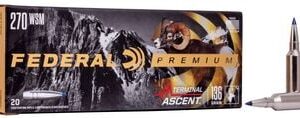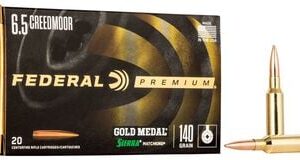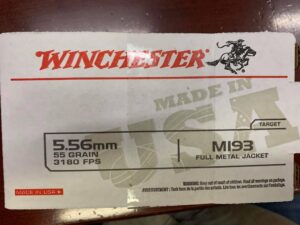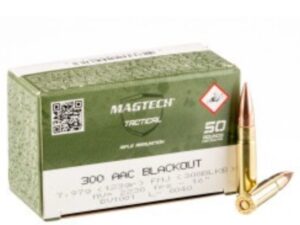Description
45 Caliber Bullets for Sale in USA
45 Caliber Bullets for sale in usa at good prices, Shop now at Ammunitionsolution.com. The Tipped TSX features a 100-percent copper body with rings cut into the shank. A polymer tip boosts the ballistic coefficient, improves long-range ballistics and provides fast expansion. The four razor sharp cutting petals double the bullet diameter making delivering “dead right there” performance.
These revolutionary bullets from Barnes are made of 100% copper and contain no lead. Barnes recommends initially seating bullets 0.050″ off the lands. Best accuracy will be found from 0.030″ to 0.070″ depending on the rifle. This is not loaded ammunition.
What is 45 Caliber Bullets?
The .45 caliber bullet, particularly in the form of the .45 ACP (Automatic Colt Pistol), is one of the most iconic and widely used handgun cartridges in the world. Known for its large diameter (.451 inches) and heavy bullet weight, the .45 ACP delivers a potent combination of stopping power, manageable recoil, and reliable performance, making it a favorite among military, law enforcement, and civilian shooters.
Overview of the .45 ACP Cartridge
Designed by John Browning in 1905, the .45 ACP was created to replace revolvers as the standard sidearm cartridge for the U.S. military. It fires a relatively large, heavy bullet—commonly 230 grains—at moderate velocities around 830 to 950 feet per second (fps), depending on the firearm platform. This results in a substantial muzzle energy typically ranging from 250 to 675 foot-pounds, sufficient for effective stopping power in self-defense and combat scenarios.
45 Caliber Bullets Ballistic Performance
-
Bullet Diameter: .451 inches (11.43 mm)
-
Typical Bullet Weight: 185 to 230 grains, with specialty loads available in lighter or heavier weights
-
Muzzle Velocity: Approximately 830 fps from pistols, up to 950 fps from submachine guns or carbines
-
Muzzle Energy: Usually between 300 and 500 foot-pounds, depending on the load and barrel length
-
Chamber Pressure: Relatively low at about 21,000 psi, which helps extend firearm service life and reduces recoil compared to higher-pressure cartridges
The .45 ACP’s large diameter bullet creates a wide wound channel, increasing the likelihood of rapid incapacitation. Even full metal jacket (FMJ) rounds, which do not expand, can penetrate deeply and cause significant tissue damage due to the bullet’s mass and size. Hollow point variants expand upon impact, increasing the diameter of the wound channel and transferring more energy to the target, which enhances stopping power while reducing the risk of overpenetration.
Advantages of .45 ACP Bullets
-
Stopping Power: The .45 ACP is renowned for its ability to incapacitate targets quickly due to its large bullet diameter and heavy weight, producing a substantial wound cavity.
-
Manageable Recoil: Despite its power, the .45 ACP generates moderate recoil that many shooters find controllable, especially in full-size handguns.
-
Low Muzzle Blast and Flash: The cartridge produces less muzzle blast and flash compared to some higher-velocity rounds, aiding in shooter comfort and maintaining night vision.
-
Versatility: Available in a wide range of bullet types and weights, including FMJ, hollow point, and specialty defense rounds.
-
Durability: The relatively low operating pressure reduces wear on firearms, extending their service life.
Common Uses
-
Military and Law Enforcement: Historically the standard U.S. military sidearm cartridge, still favored by some units and agencies for its stopping power.
-
Self-Defense: Popular among civilians for home defense and concealed carry due to its effectiveness at close range.
-
Target Shooting: Used in competitive shooting disciplines and recreational shooting for its accuracy and manageable recoil.
-
Submachine Guns and Carbines: The .45 ACP is also chambered in various short-barreled rifles and submachine guns, where its performance is enhanced by longer barrels.
Popular .45 ACP Bullet Types
| Bullet Type | Description |
|---|---|
| Full Metal Jacket (FMJ) | Non-expanding, deep penetration, commonly used for training and military applications. |
| Hollow Point (HP) | Expands upon impact, creating larger wound channels and reducing overpenetration risk. |
| Jacketed Hollow Point (JHP) | Enhanced expansion and penetration, popular for self-defense and law enforcement. |
| +P Loads | Higher pressure loads that increase velocity and energy, used cautiously in firearms rated for +P. |
45 Caliber Bullets Ballistic Considerations
The .45 ACP’s relatively low velocity results in a more pronounced bullet drop over distance compared to smaller, faster rounds. For example, shooters can expect a bullet drop of 15 to 20 inches at 100 yards, which is generally acceptable given that most defensive handgun engagements occur within 25 yards. Its large, slow-moving bullet is less effective against body armor but excels in close-range stopping power.
Comparison to Other Common Handgun Calibers
-
.45 ACP vs. 9mm: The .45 ACP offers larger bullet diameter and heavier projectiles, resulting in greater stopping power but with increased recoil and lower magazine capacity.
-
.45 ACP vs. .40 S&W: The .40 S&W delivers higher velocity and flatter trajectory but generally produces sharper recoil; the .45 ACP is favored for its softer recoil and larger wound channel.
-
.45 ACP vs. 10mm Auto: The 10mm Auto offers significantly higher velocity and energy, suitable for hunting and tactical use, while the .45 ACP remains a proven self-defense round with manageable recoil.
Summary Table of the 45 Caliber Bullets
| Feature | Specification / Typical Value |
|---|---|
| Bullet Diameter | .451 inches (11.43 mm) |
| Typical Bullet Weight | 185 – 230 grains |
| Muzzle Velocity | 830 – 950 fps |
| Muzzle Energy | 250 – 675 ft-lbs |
| Maximum Pressure | ~21,000 psi (145 MPa) |
| Effective Range | Up to 50 yards (typical handgun use) |
| Recoil | Moderate, manageable |
How does the 45 ACP’s low chamber pressure affect its longevity in firearms?
The .45 ACP’s relatively low maximum chamber pressure—around 21,000 psi compared to 35,000 psi or more in cartridges like the 9mm Parabellum—has a direct positive impact on firearm longevity. This lower pressure results in reduced bolt thrust and less stress on the firearm’s components during firing. Consequently, guns chambered for .45 ACP typically experience less wear and tear over time, which helps extend their service life and maintain reliability.
Because the .45 ACP operates at these lower pressures, it generates moderate recoil and produces less mechanical strain on barrels, chambers, and locking mechanisms. This was particularly beneficial in early 20th-century firearm designs like the Colt M1911, allowing them to function reliably over many thousands of rounds without premature failure. Even with modern metallurgy and manufacturing techniques, the low-pressure nature of the .45 ACP continues to contribute to the durability and longevity of firearms chambered for this cartridge.
However, this pressure limitation also means that the .45 ACP generally cannot safely handle higher-pressure “+P” loads in many standard firearms, as increasing pressure beyond the design limits risks damage or catastrophic failure. Some specialized variants like the .45 Super or .450 SMC have been developed to safely operate at higher pressures, but these require firearms specifically built or modified for such loads.




